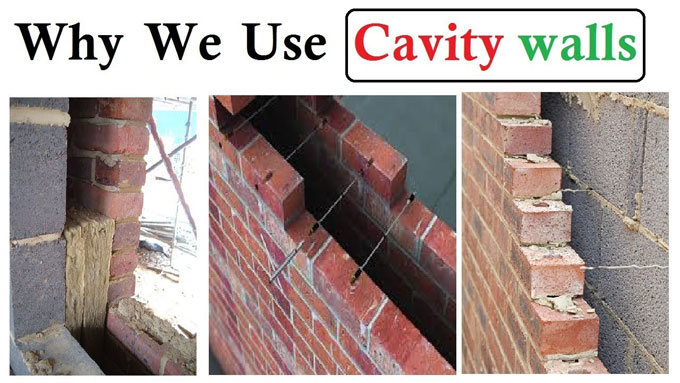
Purpose & Construction of a Cavity Wall
What Is a Cavity Wall?
Cavity Wall - It is a wall made of two equal degrees of stone work, isolated by a persistent air space. Nonstop space is known as a cavity.
Cavity walls comprise of three primary parts:
1. The external leaf which, is the outside piece of the wall
2. The cavity, the nonstop outside space
3. The inward leaf, which is the inside piece of the wall
Reason for Cavity Walls - The cavity walls are accommodated for the accompanying reason:
It is made conceivable in light of the fact that whatever dampness gets infiltrated through the external leaf is exposed to dissipation by the air inside the cavity, as cavities are kept all around ventilated.
Heat Insulation: The air in the cavity goes about as a non-conductor of warm warmth and subsequently limits the transmission of warmth from the outer substance of the inside leaf. In this way cavity walls help extraordinarily in the warm protection of the structures.
Auditory Barrier: The air in the cavity wall goes about as a pad for retaining sound, by embracing cavity walls building might be rendered soundproof as significant outside commotion gets ingested in the cavity.
Blossoming: As suddenness isn't permitted to enter by a cavity, the internal wall of the cavity which is constantly a heap bearing wall is kept liberated from blooming impact.
Economy: Cavity walls are found to cast about 20% of the construction of the same thickness strong wall.
Size And Location of Cavity Wall: The cavity between two leaves ought at the very least 50 mm and not in excess of 75 mm. The cavity might be fixed or ventilated.
A fixed cavity is increasingly successful for warm protection. Meanwhile a ventilated one is progressively powerful for soggy counteraction ventilation of cavities might be gotten by utilizing an air block in the external leaf close to base and top of the cavity.
The cavity might have begun from the highest point of the foundation concrete square, yet it is seen that the cavity beneath the sodden evidence course doesn't fill any need. Henceforth dependent upon 100 to 300 mm beneath D.P.C. at plinth level, brickwork in the foundation is commonly built strong.
The cavity might have begun uniquely around 150 mm beneath the D.P.C. level. This 150 mm profundity beneath DPC helps in drawing any dense dampness underneath the degree of DPC.
Soggy evidence course for the two leaves of the wall is determined to an individual premise bye at a comparable level.
The cavity may lead straight up to the highest point of the parapet and changed over by replicating and D.P.C. It might have halted levels yet D.P.C. must be laid over the cavity.
Installation Details of Cavity Wall: The cavity walls have two leaves inward and external with hollows in the middle of them. Width of the cavity shifts from 50 mm to 75 mm.
The thickness of the external leaf of the wall which is typically a non-load bearing wall is half-block. Inward wall is consistently load-bearing and its thickness ought not be short of one block.
The two pieces of the wall are associated by wall ties or fortified blocks. Metal wall ties are dispersed at level intervals of about 0.90 mm and vertical interim of 450 mm.
The wall tie ought to be orchestrated in a staggered manner. The external wall is consistently in stretcher bond, however it very well may be developed in different bonds too by utilizing brickbats.


